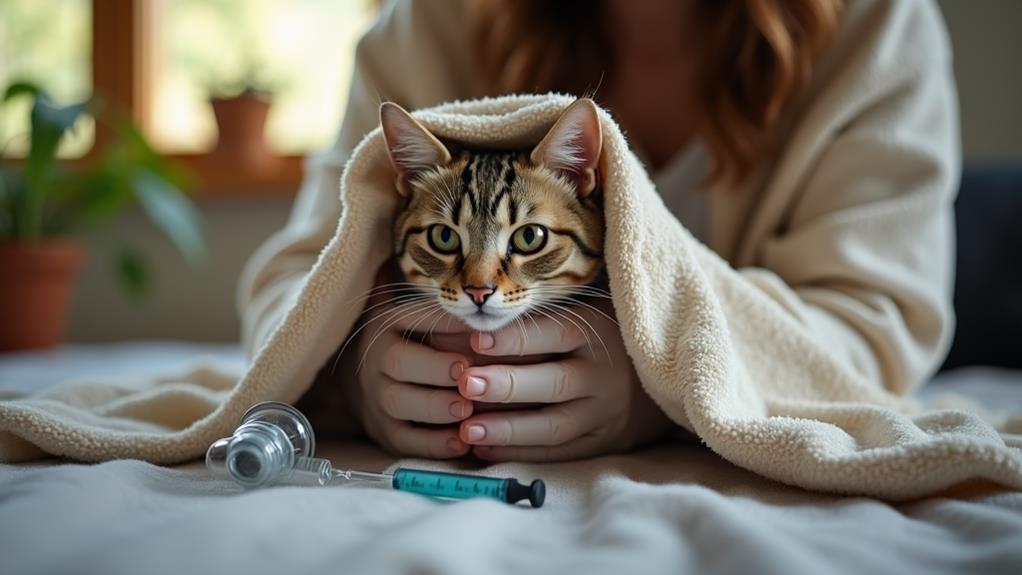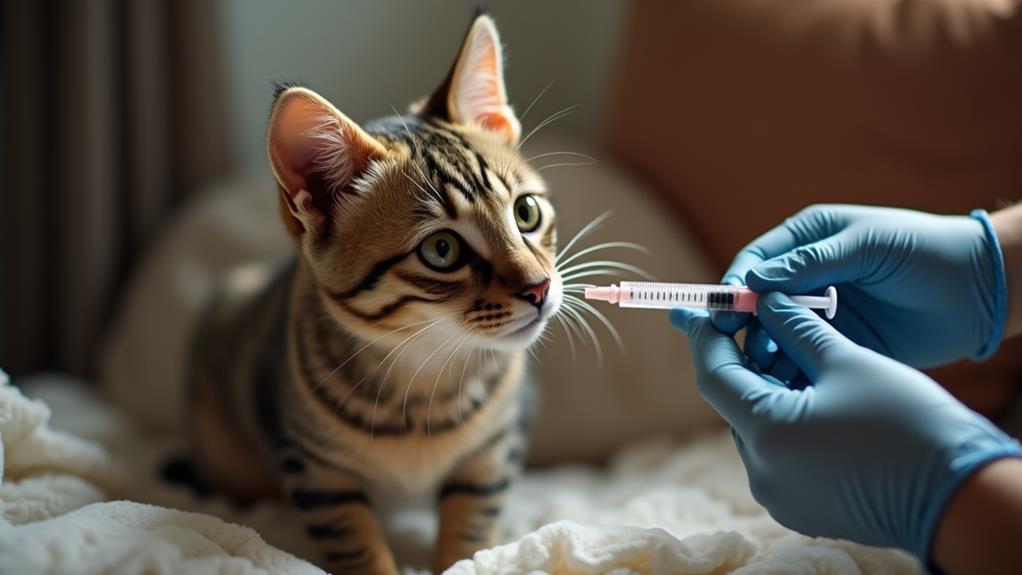How to Administer Medicine to a Feral Cat: Techniques for Success

When administering medicine to a feral cat, your approach should focus on safety and minimizing stress. Equip yourself with a syringe for liquid medication, aiming for the back third of the cat's tongue to guarantee absorption and reduce reactions like foaming. Position the cat's chin upward to encourage swallowing, and wrap the cat in a towel with its head exposed for control. Create a calm setting with soothing sounds and, if necessary, enlist a second person for assistance. Maintaining a steady demeanor is essential. Investigate further techniques and strategies to improve your success and build confidence in the process.
Importance of Medication
Timely medication is vital for the recovery and well-being of sick feral cats. When left untreated, their conditions can worsen, leading to severe health complications. As a caregiver, you should make sure to prioritize administering medication promptly to improve their chances of recovery. Liquid medications, like buprenorphine, can make it easier to medicate feral cats, as these can be absorbed through the mouth's mucous membranes without forcing the cat to swallow. This method is particularly effective for feral cats, who might not be used to human touch and could resist handling.
You'll find that the oral route of administering medicine is the simplest and most cost-effective option. This approach minimizes stress for both you and the cat, creating a smoother experience in general. Understanding the importance of medication adherence is vital because it greatly improves treatment outcomes. By ensuring that the feral cats consistently receive their medication, you're actively contributing to their recovery and long-term well-being.
To raise the likelihood of successful administration, take time to familiarize yourself with the cat's behavior and the medication itself. This preparation can enhance your confidence, making the process more manageable and effective.
Essential Tools and Techniques
When it relates to giving medicine to a feral cat, having the right tools and techniques is essential to guarantee a smooth process. Start with syringe selection: opt for a 1cc or 3cc syringe. These sizes are perfect for administering liquid medications because they facilitate easier dosage measurement and minimize spillage. To prepare, position the feral cat facing away from you. This allows you to maintain better control—use one hand to secure the cat and the other for administering the medication.
It's important to deliver the medicine to the back third of the cat's tongue. This technique helps avoid foaming and guarantees effective absorption. After administering, tilt the cat's chin up for about three seconds to make certain the medication goes down smoothly.
For stress reduction, familiarize the cat with the syringe and medication gradually. Introduce these elements in a calm and composed manner to ease anxiety. Creating a relaxed environment is key—ambient noise should be minimal, and your movements should be slow and deliberate. A stress-free setting greatly increases the chances of successful medication administration, making the whole process more manageable for both you and the cat.
Handling Cat Reactions

Having the right tools and techniques is just the beginning; understanding how to handle a cat's reactions during medication administration is just as crucial. Cats can exhibit a range of behaviors, especially when they encounter unfamiliar or unpleasant medication flavors. You might notice foaming at the mouth when the medication doesn't suit their palate. This isn't harmful, but it does indicate a strong reaction. To minimize this, aim to administer the medicine to the back third of the tongue, avoiding the front where foaming is more likely.
As you work with your cat, focus on anxiety reduction. Your calm and composed demeanor can greatly ease their apprehension. Familiarizing them with the medication over time can also lead to better acceptance. Gradually exposing them to the medicine's presence and smell can reduce their stress in future administrations, improving their general response.
Effective Positioning Strategies
Positioning a feral cat correctly is vital for both safety and effectiveness when administering medication. Start by creating a safe environment, like an enclosed room or carrier, to minimize escape opportunities. This reduces stress and makes handling ferals much more manageable. Use calming techniques, such as speaking softly or playing soothing music, to help keep the cat relaxed.
To position the feral cat effectively, wrap it gently in a towel or blanket. This secures its limbs, preventing injury to both you and the cat. Make sure to leave the head exposed for easy access while keeping the body stable. If possible, enlist a second person to assist. They can hold the cat securely, allowing you to focus on administering the medication without distraction.
Confirm the cat is facing away from you. This positioning provides better access to its mouth while giving you control over its movement. Maintaining a calm demeanor throughout this process is significant. Handling ferals with patience and care helps make the experience less intimidating for both you and the cat. These strategies guarantee the medication process is as smooth and stress-free as possible.
Building Community Support

While caring for feral cats may seem intimidating, building community support can greatly ease the process. Start by joining online communities or forums focused on feral cat care. These platforms provide valuable insights and allow for resource sharing among fellow caregivers. You'll find shared experiences and tips on administering medicine, making the task less intimidating.
Participating in local TNR (Trap-Neuter-Return) programs is another effective way to establish connections. These programs unite people who are committed to improving the lives of feral cats. Through community outreach, you can foster relationships that may lead to mentorship programs, where experienced caregivers guide you through the intricacies of cat care.
Engaging with veterinary professionals during community workshops or events can also improve your skills. They often offer hands-on demonstrations and advice on medication techniques specific to feral cats. Connecting with them guarantees you have access to reliable guidance when you need it.
Social media groups dedicated to feral cat advocacy are another excellent resource. They provide ongoing support and solutions tailored to medication administration challenges. Ultimately, organizing or participating in community fundraising efforts guarantees a steady supply of necessary resources, strengthening the support network for both you and the cats.
Additional Considerations
As you build community support, there are supplementary considerations to keep in mind when administering medicine to feral cats. Initially, timing considerations are vital. Administer medication during a time when the cat is most relaxed, often early morning or late evening. This reduces stress and increases compliance.
Secondly, focus on dosage accuracy. Use a syringe or dropper for liquid medicines to measure exact amounts, guaranteeing the cat receives the proper dose without waste.
Thirdly, consider environmental factors. Choose a quiet, familiar setting for the cat, minimizing external stressors. Incorporate familiar scents or treats to ease anxiety, enhancing the likelihood of successful dosing.
Fourth, practice your technique on a non-feral cat initially. This builds your confidence and ensures you're ready to handle the unpredictability of a feral cat.




